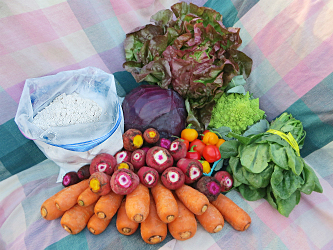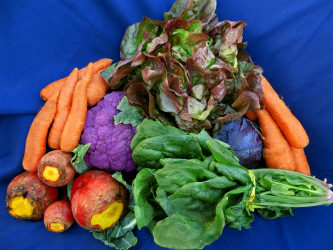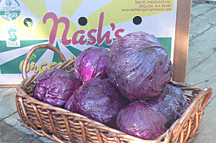
Standard
Romanesco 1 hd
Spinach 1 bu
Carrots 3 lb
Beets, small mixed 2 lb
Red Cabbage 1 hd
Soft White Wheat Flour 4 lb
Mini Sweet Red/Orange
Peppers 1 pt
Red Butter Lettuce
from River Run Farm 1 hd
 Small
Small
White or Purple Cauliflower 1 hd
Spinach 1 bu
Carrots 2.5 lb
Red Cabbage 1 hd
Gold Beets 2.5 lb
Red Butter Lettuce
from River Run Farm 1 hd
Red Butter Lettuce from River Run Farm
We are proud to promote new local farms and bright, innovative young farmers, who are critical to the viability of a dynamic and sustainable local food system. Your delicious lettuce this week comes from a farm that is relatively new. Co-founded in 2013 by friends sharing a deep reverence for good food and good living, River Run Farm raises organic vegetables, berries and flowers along the Dungeness River near Sequim. The farm’s founders look to nature for inspiration in the continuing development of their farming practices and do not use synthetic chemical fertilizers, pesticides or herbicides.
They offer fresh, vibrant produce and flowers to the community on the Olympic Peninsula and in Seattle. Their produce and flowers can be purchased at the farm at 2800 Woodcock Rd., local farmers markets and in local grocery stores, including Nash’s Farm Store.
Below: the crew from River Run Farm

Mini Red/Orange Peppers
People purchase more green peppers than any other color, maybe because they are less expensive. That’s because they are unripe!
These peppers start off green. Then they gradually turn yellow, orange, then red as they ripen. Because they are harvested before they are ripe, the green ones lack a lot of nutrients, and they are not sweet.
By the time a pepper has gotten orange or red, it is much sweeter and it has 11 times more beta-carotene, about two times more vitamin C and ten times more vitamin A than the green bell pepper.
The USDA has found residues from at least 53 different pesticides on commercial, nonorganic peppers. Some of these are carcinogenic and some are toxic for bees. Peppers are one of “The Dirty Dozen”—produce that should always be consumed organic because it carries a heavier-than-usual pesticide load. See link.
Because these tiny peppers are sweet, they are delightful raw. Add to salads or pizza; cut in half, remove seeds, and fill with hummus for an appetizer; roast them or even grill them quickly; or stuff them with cheese or ground meats and bake. Perfect bite-sized!

Red Cabbage
Red cabbages are easy to prepare. Strip off the outer leaves, wash, then slice into quarters, cut out the hard central core on each, then chop or shred.
Lock in the color by adding a touch of vinegar when cooking red cabbage in water. This stops the lovely deep purple hue from running.
Don’t be too heavy-handed with red cabbage. A lot of its frumpy reputation comes from it being over-pickled or boiled for an eon. Although it’s a sturdy vegetable it’s not invincible.
Go raw. Lock in nutrients by eating your cabbage uncooked in salads. Just make sure you slice it very finely.
Warm Red Cabbage Bacon Salad
3 slices bacon
1½ Tbsp. olive oil
½ large onion, peeled and chopped
3 large ribs celery, sliced
⅓ cup cider vinegar
3 Tbsp. sugar
½ tsp. celery seed
½ large head red cabbage, shredded (about 6 cups)
Salt and freshly ground black pepper (optional)
2 Tbsp. chopped fresh parsley, for garnish
Cut the bacon slices into 1-inch pieces and sauté them over medium-low heat in a very large, deep skillet until they are crisp but not overdone. Transfer them to absorbent paper towels and reserve. Drain off all of the bacon fat from the pan, wipe it clean, and replace with the olive oil.
Heat the oil in the skillet over high heat. Add the onion and celery and sauté briefly. Add the vinegar, sugar, and celery seed. Heat until the mixture boils, then immediately add the cabbage and bacon pieces all at once. Stir and toss for about 1 minute, or until the cabbage is warm but not cooked. Season to taste with salt and pepper.
Serve the salad immediately while it is still very warm, with a garnish of chopped parsley.
— Produce for Better Health; Fruits & Veggies—More Matters; Centers for Disease Control and Prevention, as appears in Bounty from the Box: The CSA Farm Cookbook, by Mi Ae Lipe
